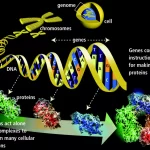
Clustal Omega: A Comprehensive Guide for Biologists
November 7, 2023Sequence Alignment in Biology with Clustal Omega
Introduction: Sequence alignment is a fundamental technique in biology, providing insights into evolutionary relationships, functional analysis, and structural features of biological sequences. Clustal Omega is a powerful tool for performing multiple sequence alignments, enabling researchers to compare and align sequences efficiently. In this guide, we will introduce the concept of sequence alignment, explain the importance of Clustal Omega, and provide a step-by-step guide on using Clustal Omega for multiple sequence alignment. We will also explore the applications of sequence alignment in comparative genomics, phylogenetics, and homology analysis, and discuss how to interpret alignment results and identify conserved regions. Real-life case studies will illustrate the significance of sequence alignment in various biological contexts.
Section 1: Introduction to Sequence Alignment
1.1 Sequence Alignment Basics:
- Overview of sequence alignment and its significance in biology.
1.2 Types of Sequence Alignment:
- Introduction to pairwise and multiple sequence alignment.
- When to use each type for different biological questions.
Section 2: Using Clustal Omega for Multiple Sequence Alignment
2.1 Clustal Omega Overview:
- Introduction to Clustal Omega and its role in sequence alignment.
2.2 Step-by-Step Guide:
- Detailed instructions on using Clustal Omega for multiple sequence alignment.
- Exploring alignment options and parameters.
Section 3: Applications in Comparative Genomics, Phylogenetics, and Homology Analysis
3.1 Comparative Genomics:
- How sequence alignment aids in comparing genomes for evolutionary insights.
3.2 Phylogenetics:
- The role of sequence alignment in building phylogenetic trees and inferring evolutionary relationships.
3.3 Homology Analysis:
Section 4: Interpretation of Alignment Results and Conserved Regions
4.1 Alignment Output:
- Understanding the output of Clustal Omega alignments.
4.2 Conserved Regions:
- Identifying conserved regions and functional motifs in aligned sequences.
Section 5: Real-Life Case Studies
5.1 Evolutionary Insights:
- Case study illustrating how sequence alignment uncovered evolutionary relationships.
- Real-world example of how sequence alignment aids in functional annotation of proteins.
By the end of this guide, you will have a comprehensive understanding of sequence alignment in biology and how to use Clustal Omega for multiple sequence alignment. You will be equipped to apply sequence alignment to various biological questions, from comparative genomics and phylogenetics to homology analysis and functional annotation, making it an invaluable tool for biological research and analysis.
Clustal Omega in Microbial Genomics and Phylogenetics
Introduction: Clustal Omega is a versatile tool that plays a significant role in the field of microbial genomics and phylogenetics. This guide will explore how Clustal Omega aids in the analysis of microbial genomes and the study of phylogenetic relationships among microorganisms. We will delve into the use of Clustal Omega for aligning 16S rRNA sequences in microbiology, building microbial phylogenetic trees for taxonomic classification, detecting and comparing conserved genes in microbial genomes, and gaining insights into microbial evolution and diversity. Real-life examples and case studies will illustrate how Clustal Omega is employed in various microbiological studies.
Section 1: Aligning 16S rRNA Sequences in Microbiology
1.1 The Role of 16S rRNA:
- Introduction to the importance of 16S rRNA sequences in microbial identification and classification.
1.2 Using Clustal Omega for Alignment:
- Step-by-step guide on aligning 16S rRNA sequences using Clustal Omega.
- Tips for optimizing alignment parameters in microbiological research.
Section 2: Building Microbial Phylogenetic Trees for Taxonomic Classification
2.1 Phylogenetic Classification:
- Understanding the significance of microbial phylogenetic trees in taxonomic classification.
2.2 Constructing Phylogenetic Trees:
- How to use Clustal Omega to build microbial phylogenetic trees.
- Interpretation of tree topology and branch lengths.
Section 3: Detecting and Comparing Conserved Genes in Microbial Genomes
3.1 Conserved Genes in Microbial Genomes:
- Exploring the concept of conserved genes and their role in microbial genomics.
3.2 Clustal Omega for Gene Alignment:
- Using Clustal Omega to detect and align conserved genes in microbial genomes.
- Comparative analysis of gene sequences.
Section 4: Insights into Microbial Evolution and Diversity
4.1 Microbial Evolution:
- How sequence alignment and phylogenetics shed light on microbial evolution.
4.2 Microbial Diversity:
- Analyzing microbial diversity and the identification of new taxa through sequence analysis.
Section 5: Examples of Microbiological Studies Using Clustal Omega
5.1 Taxonomic Classification:
- Case study illustrating the use of Clustal Omega in microbial taxonomic classification.
5.2 Comparative Genomics:
- Real-life example of comparative genomics using Clustal Omega in a microbial context.
By the end of this guide, you will have a comprehensive understanding of how Clustal Omega is utilized in microbial genomics and phylogenetics. You will be equipped to apply Clustal Omega to align 16S rRNA sequences, build phylogenetic trees, analyze conserved genes, and gain insights into microbial evolution and diversity. These skills are invaluable for researchers in microbiology and microbial ecology, enabling the exploration and classification of microorganisms in various ecological niches.
Molecular Biology and Sequence Motif Analysis with Clustal Omega
Introduction: Clustal Omega is a powerful tool in molecular biology and bioinformatics, enabling researchers to identify conserved motifs and regulatory elements in DNA and protein sequences. In this guide, we will explore how Clustal Omega can be harnessed to discover conserved regulatory elements in DNA, analyze protein families for common structural motifs, investigate functional domains in proteins, and understand the role of sequence alignment in promoter analysis and gene regulation. Practical examples and case studies will highlight how Clustal Omega is applied to uncover critical sequence motifs in various molecular biology contexts.
Section 1: Identifying Conserved Regulatory Elements in DNA Sequences
1.1 Regulatory Elements in DNA:
- Introduction to the significance of regulatory elements in gene expression.
1.2 Using Clustal Omega for Motif Discovery:
- Step-by-step guide on how to identify conserved regulatory elements in DNA sequences with Clustal Omega.
- Customization of alignment parameters for motif analysis.
Section 2: Analyzing Protein Families for Common Structural Motifs
2.1 Structural Motifs in Proteins:
- Understanding the role of structural motifs in protein function.
2.2 Protein Family Analysis:
- How to use Clustal Omega to analyze protein families for common structural motifs.
- Interpreting the alignment results in a structural context.
Section 3: Investigating Functional Domains in Proteins
3.1 Functional Domains in Proteins:
- Introduction to functional domains and their role in protein functionality.
3.2 Domain Analysis with Clustal Omega:
- Using Clustal Omega to investigate functional domains in proteins.
- Case studies demonstrating the identification of important protein domains.
Section 4: Role of Sequence Alignment in Promoter Analysis and Gene Regulation
4.1 Promoter Analysis and Gene Regulation:
- Understanding how sequence alignment contributes to promoter analysis and gene regulation studies.
4.2 Clustal Omega in Promoter Analysis:
- How to apply Clustal Omega to study promoter sequences and regulatory elements.
Section 5: Practical Examples of Motif Discovery Using Clustal Omega
5.1 DNA Motif Discovery:
- Case study illustrating the discovery of conserved DNA motifs using Clustal Omega.
5.2 Protein Motif Analysis:
- Real-world example of protein motif analysis in a molecular biology context.
By the end of this guide, you will have a comprehensive understanding of how Clustal Omega can be used in molecular biology and sequence motif analysis. You will be equipped to identify conserved regulatory elements in DNA sequences, analyze protein families for structural motifs, investigate functional domains in proteins, and apply sequence alignment in promoter analysis and gene regulation. These skills are invaluable for researchers in genomics, bioinformatics, and molecular biology, allowing them to uncover critical motifs and elements in DNA and proteins for various biological applications.
Structural Biology and Biochemical Insights with Clustal Omega
Introduction: Clustal Omega is a versatile tool that plays a significant role in structural biology and biochemistry, enabling researchers to align protein structures, analyze ligand-binding sites and active domains, predict protein-protein interactions, and apply these insights in drug discovery and enzyme-substrate studies. In this guide, we will explore how Clustal Omega can be used to align protein structures for 3D modeling and structural comparisons, investigate key biochemical features in proteins, and understand its applications in drug discovery and enzymatic substrate analysis. Real-life case studies will illustrate how Clustal Omega is employed in structural biology and biochemistry.
Section 1: Aligning Protein Structures for 3D Modeling and Structural Comparisons
1.1 Protein Structure Alignment:
- Introduction to the significance of protein structure alignment in structural biology.
1.2 Using Clustal Omega for Structural Alignment:
- Step-by-step guide on using Clustal Omega for aligning protein structures.
- Optimizing alignment parameters for 3D modeling and structural comparisons.
Section 2: Analyzing Ligand-Binding Sites and Active Domains
2.1 Ligand-Binding Sites:
- Understanding the importance of ligand-binding sites in protein function.
2.2 Clustal Omega for Site Analysis:
- How to use Clustal Omega to investigate ligand-binding sites and active domains in proteins.
- Interpreting the results for functional analysis.
Section 3: Predicting Protein-Protein Interactions through Sequence Alignment
3.1 Protein-Protein Interactions:
- Introduction to the role of protein-protein interactions in biochemistry.
3.2 Sequence Alignment for Interaction Prediction:
- Predicting protein-protein interactions using Clustal Omega-based approaches.
- Interpreting the alignment results for interaction analysis.
Section 4: Applications in Drug Discovery and Enzyme-Substrate Studies
4.1 Drug Discovery:
- Real-life examples of using Clustal Omega in drug discovery, including target identification and validation.
4.2 Enzyme-Substrate Studies:
- Case studies illustrating the use of Clustal Omega in enzyme-substrate studies, including substrate specificity and catalytic mechanisms.
Section 5: Case Studies
5.1 Structural Insights:
- Case study illustrating the use of Clustal Omega in gaining structural insights into protein functions.
5.2 Drug Design:
- Real-world example of drug design applications using Clustal Omega in structural biology and biochemistry.
By the end of this guide, you will have a comprehensive understanding of how Clustal Omega can be employed in structural biology and biochemical analysis. You will be equipped to align protein structures for 3D modeling and structural comparisons, investigate ligand-binding sites and active domains, predict protein-protein interactions, and apply these insights in drug discovery and enzyme-substrate studies. These skills are invaluable for researchers in structural biology, biochemistry, and drug discovery, enabling them to uncover crucial insights into protein structures and their biochemical functions.


















